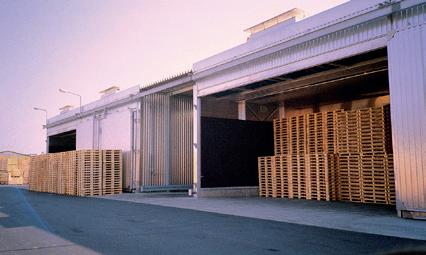
3 minute read
22
Brunner Hildebrand sets tone for North American wood drying
Industry stalwart pushes the limits of what’s possible in kiln drying technology to raise the bar on finished wood products for what has become an incredibly competitive market
Advertisement
Specializing in kilns for softwood and hardwood, Brunner-Hildebrand Lumber Dry Kiln Co has been a proven leader in the industry since 1948. Located in Nashville, US, the company provides sales and service for all types of kilns.
Brunner-Hildebrand’s dry kiln solutions are based on decades of experience in the demanding lumber drying conditions of the North American sawmill industry. The company’s expertise ensures that customers receive individual dry kiln solutions tailored to the needs of each mill, with special focus on desired capacity and lumber grade.
The possibility of future expansion is always taken into account when designing the kiln layout. The company´s priority is in providing the best-engineered, installed, and serviced product in the market today. BrunnerHildebrand’s service network is on stand-by to provide full service support after delivery and installation, either on location or by remote access.
Batch kilns
Track and forklift-loaded kilns are designed for all kinds of lumber packages with regard to dimensions, lumber species, and required moisture content. Stateof-the-art automation ensures a fully-controlled drying process and the required end result.
Track loaded kilns offer shorter loading/unloading time which improves the kiln’s utilization rate. An optional shelter on both sides of the kiln may be used as a temporary storage space.
Continuous kilns
Brunner-Hildebrand recently introduced their new highly efficient continuous-type kiln, the Hildebrand Continuous Kiln Alexander (HCK-A). This type of continuous kiln is designed for mills that produce large volumes of lumber, e.g. dimension SPF.
While designing the HCK-A, the company put great emphasis on creating exactly the right drying
conditions (temperature, climate, air speed) for the respective lumber moisture content. The technical features of each individual drying zone are customized to the drying state and moisture of the lumber passing through.
Lumber packages are placed lengthwise on carts and dried during transport through a number of zones with separate climate conditions. These conditions are perfectly adjusted to the lumber moisture content at all times.
Indexing of the kiln carts is performed by powerful hydraulic pusher units. Also featuring the ‘GreenKiln’ technology for energy management and the Hildebrand Turbo Technology (HTT) to ensure tight final moisture distribution for maximum planer yield.
Heat treatment kilns ISPM15
More and more countries demand that the wooden packaging of imported goods comply with ISPM 15. Brunner-Hildebrand has developed an entire line of kilns specialized in heat treatment of pallets and wooden packaging. Short temperature ramp-up time and strong airflow make for fast kiln throughput. The dry kiln software is equipped with
elaborate features for process documentation.
Dry & Heat Treatment Kilns are Control system B-Vector EW

Due to the Brunner-Hildebrand dry kiln automation and control system, the kilns are easy to operate. Creating default settings and using the control system is similar to the Windows operating system, where windows can be chosen from a drop-down menu.
The B-Vector control system can be designed with a hybrid relative humidity measuring system where EMC wafers are used from greento-30% MC and then the wet bulb system kicks in automatically for the MC range between 30-10%. The idea here is to take advantage of the accuracy levels of both measuring systems. Of course, either system is also applicable for the full drying cycle.
B-Vector EW also features the brand-new Brunner-Hildebrand Weight Precision Technology (HWPT), which is a lumber moisture measurement system capable of weighing whole lumber stacks wirelessly.
One of the flaws of common inkiln-probe systems and electrical resistance metering is that they only consider between six and 12 probes for the entire lumber load in the kiln. The HWPT system, however, takes into account the weight of the entire stack of lumber that rests on top of its weighing devices.
Therefore, the number of probes is increased to hundreds or even thousands of boards in those lumber packages. The benefits: “unparalleled” precision of the resulting average mc along with “perfect” ease of use since no probes have to be placed, according to the manufacturer.
The weighing devices are simply placed on the kiln floor as replacement of the regular 4x4” lumber spacers.






